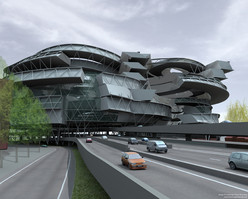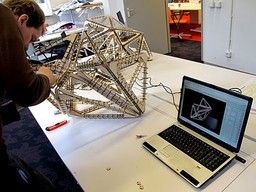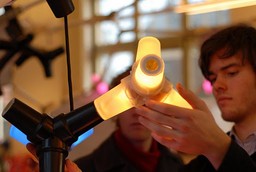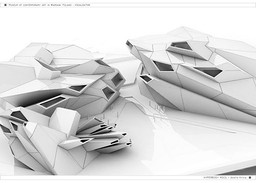
-
-
-

- MSc4 Design Studio, Hyperbody, Spring Semester 2007, Student: Owen Slootweg
-
-
- EDUCATION
- Program
- Head of program
- Prof. Ir. K. Oosterhuis
- Education Coordinators
- Dr. H.H. Bier, Dr. N.M. Biloria
- email:
- H.H.Bier AA tudelft DDD nl
N.M.Biloria AA tudelft DDD nl
-
-

- INFOMATTERS, MSc3 Design Studio, Hyperbody, Fall Semester 2009, Tutors: Dr. Nimish Biloria, Marco Verde Eng, MArch
Non-Standard and Interactive Architecture in education
Even though computer-based systems have increasingly been incorporating aspects of knowledge about the designed objects, they are either excluded from the current architectural curriculum or included as representation tools. In response, Hyperbody offers students the opportunity to not only represent but also develop design projects by employing computer-based systems incorporating aspects of intelligence. These systems enable design and construction of non-standard architecture as well as implementation of interaction in architecture; these systems make the quest for a paradigm shift not only in architecture but also in the education of architects more relevant than ever.
The independently established Hyperbody chair has in 2008 launched a complete MSc 1-4 and Post-MSc track on Non-Standard and Interactive Architecture with the goal of implementing innovative architecture employing state-of-the-art material and information logistics. In this context, Non-Standard Architecture is defined as an architecture, which departs from modernist, repetitive, mass-production principles in order to address complexity, variation, and mass-customization. Furthermore, interactivity in architecture is addressed at the level where building components and buildings become dynamic, acting and re-acting in response to environmental and user-specific needs.
Hyperbody focuses not only on issues of interdisciplinary design implemented in digitally and electronically augmented spatial environments but also on prototype development for non-standard and interactive architecture. In addition to implementation and development of computer-based methodologies for design conceptualization, representation, and simulation, Hyperbody addresses issues of computer-aided design and manufacturing employing parametric design and building information modelling. In this context, real-time interactive environments are conceived as connectivities between buildings and building components via embedded sensor-actuator technologies. These enable emergent spatial behaviours through real-time data-exchange-based on multi-player game designs.
The BSc-MSc program offered by Hyperbody introduces students to topics such as interactive architecture, parametric design, scripting- and programming-based design, and Computer-aided Design and Manufacturing (CAD-CAM) processes employing collaborative computer-based platforms for knowledge generation and exchange. BSc students develop interactive prototypes using, among other things, sensor-actuator technologies and parametric design principles, while 3D modelling and gaming software is employed for the development and implementation of projects supported by CAD-CAM techniques.
With respect to content, topics such as interactive architecture, parametric design, scripting- and programming-based design, CAD-CAM processes and collaborative computer-based platforms for information generation and exchange are addressed in lectures, seminars, courses, workshops and studios.

- Interactive Environments, Minor Design Studio, Hyperbody & ID-StudioLab, Fall Semester 2009, Tutors: Tomasz Jaskiewicz, Aadjan van der Helm, Walter Aprille
Minor
Minor: Interactive Environments is a collaborative project with the Industrial Design Faculty within TU Delft and addresses issues of interactivity in architecture. Architecture increasingly incorporates aspects of dynamics and interactive-kinetics, while sensor-actuator technologies enable building components to interact with their surroundings in a self-organized manner. This implies that interactive, digitally-driven architectures integrate bottom-up organization principles, referring to processes in which the organization of a system is not only generated automatically but also increases without being controlled from outside.
Emergent, bottom-up design processes based on swarms, cellular automata, and genetic algorithms replace in part the exclusive control of the architect. Swarms, for instance, are employed in generative design processes as well as in interactive systems, which deal with ample amounts of data featuring sometime conflicting attributes and characteristics. Those attributes and characteristics are incorporated in behaviours according to which building components swarm and configure themselves into specific spatial arrangements. The Minor on Interactive Environments addresses, therefore, issues of self-organization on the level of soft- and hardware implemented into interactive prototypes for architecture.

- Agata Kycia, MSc4 Design Studio, Hyperbody, Spring Semester 2010, Tutors: Dr. Nimish Biloria and Dr.-Ing. Henriette Bier
MSc 1-2
MSc 1-MSc2: Non-Standard and Interactive Architecture Basics introduces the use of computers not only pragmatically but also conceptually, as instruments to explore complex systems of organization in architecture. While Non-Standard Architecture introduces MSc 1-2 students to digital technologies in architecture by implementing computer-based concepts and methods in design and building construction, Interactive Architecture addresses within MSc 3-4 issues of interactivity between users and buildings.
MSc 3-4
MSc 3-MSc4:Transportation Hub nominated for Archiprix 2009. Furthermore, Hyperbody graduates work in a range of settings and capacities, including cutting-edge architectural and engineering firms, as well as research and academic institutions.
Post-MSc
Post-MSc: Customizations is a post-graduate program offered by Hyperbody in collaboration with fourteen European universities that focuses on Non-Standard Architecture (NA) and addresses implementation of mass-customization in design, implementation of 3D-modelled complex geometries by means of Rapid Prototyping and Computer Numerically Controlled fabrication (CNC).
The post-graduate program introduces students to generative and parametric design concepts as well as CAD-CAM principles enabling them to develop designs that depart from standardization and repetition in order to address uniqueness and customization in architecture, which seems to have become as easy and economic to achieve as repetition. Addressing issues such as designing and constructing complex building components, buildings, and building clusters within an urban context, this program engages in procedural and object-oriented studies enabling students to implement mass-customization in architectural design.
BSc-MSc and Post-MSc programEcodomus program, which enables students to prepare for doctoral studies within the field of Non-Standard and Interactive Architecture.
 Facebook/
Facebook/
 Twitter/
Twitter/
 RSS
RSS
